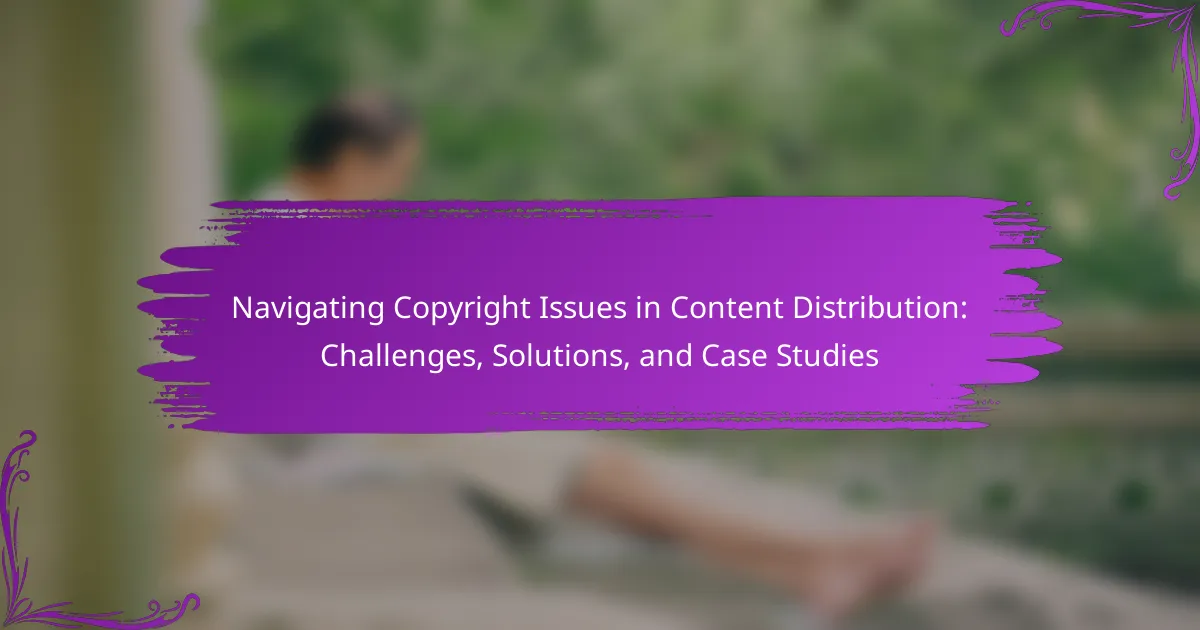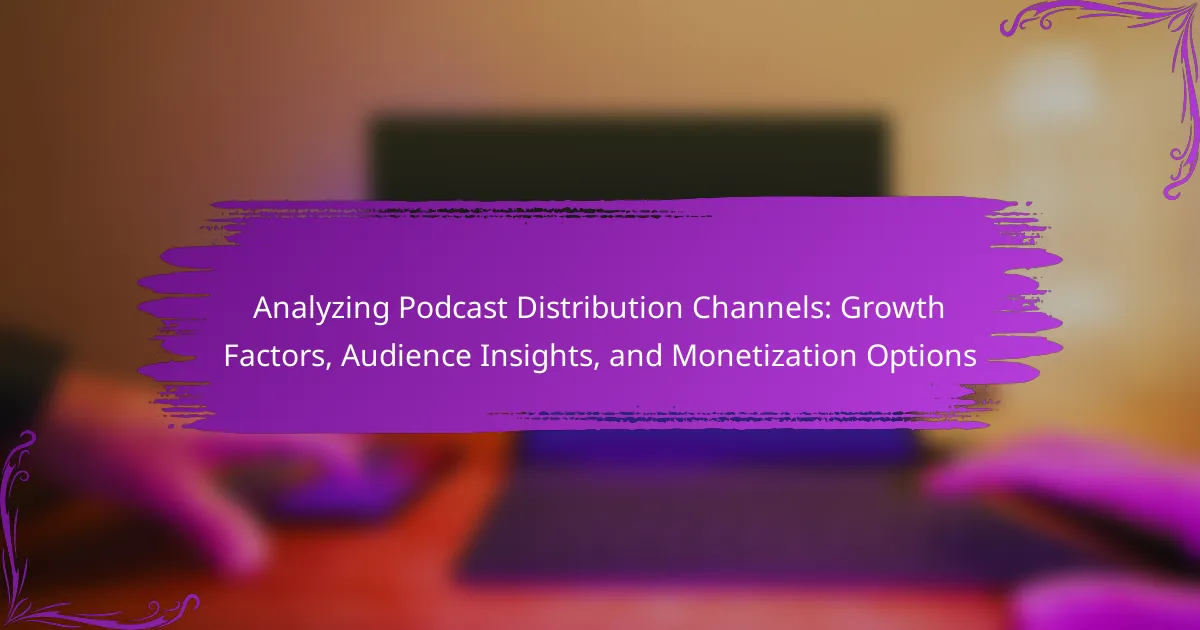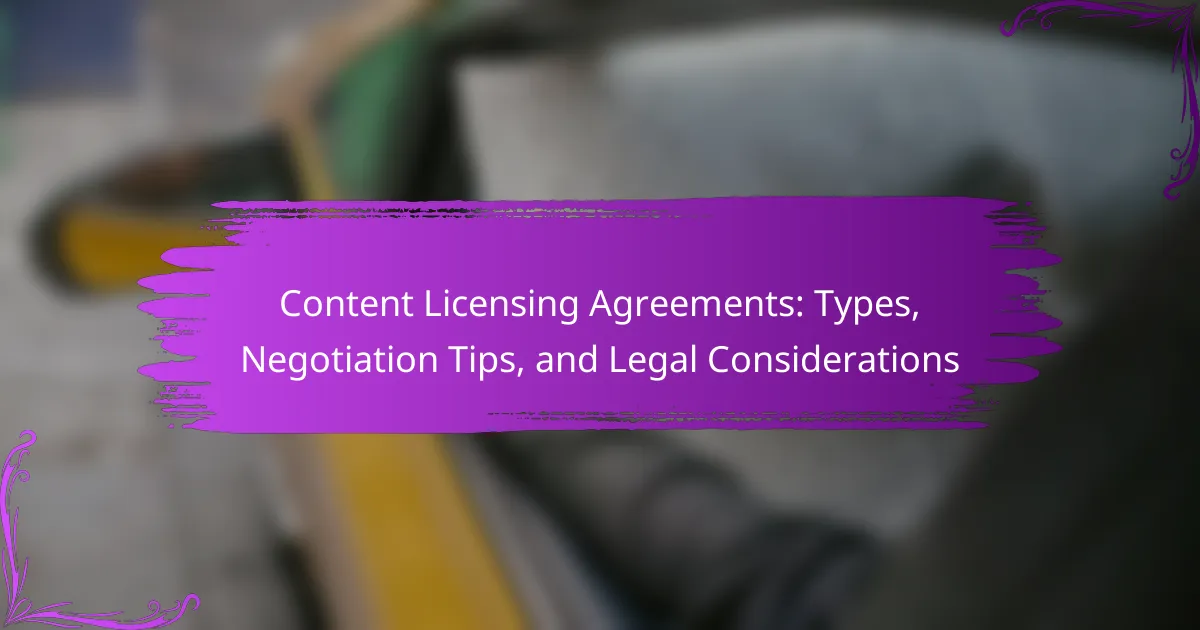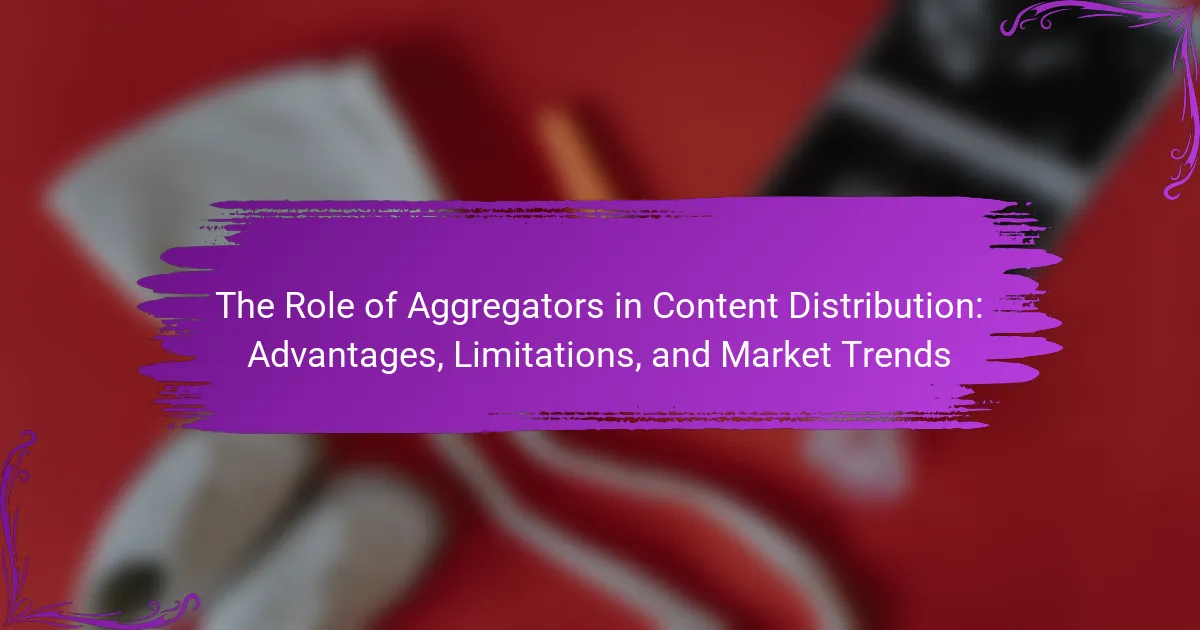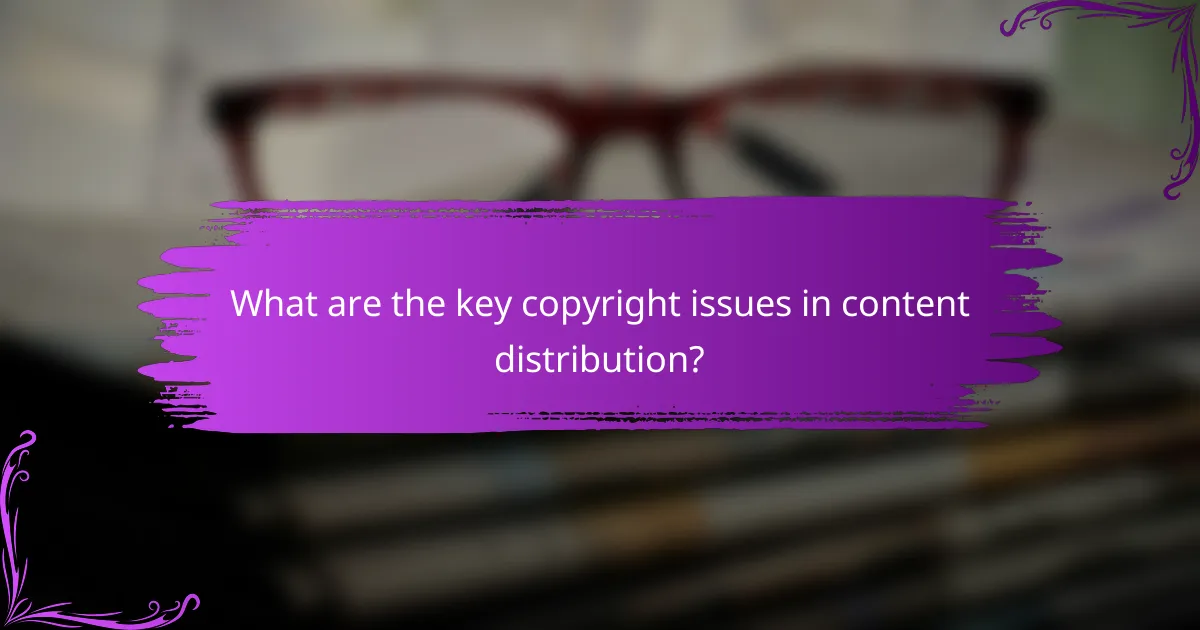
What are the key copyright issues in content distribution?
Key copyright issues in content distribution include unauthorized reproduction, distribution rights, and licensing agreements. Unauthorized reproduction occurs when content is copied without permission from the copyright holder. Distribution rights refer to the legal authority to share content publicly or commercially. Licensing agreements outline the terms under which content can be used or shared.
Additionally, fair use is a complex issue that allows limited use of copyrighted material without permission under certain conditions. Misinterpretation of fair use can lead to legal disputes. Digital rights management (DRM) technologies also present challenges by restricting how content is accessed and shared.
Infringement penalties can be severe, including financial damages and injunctions against further distribution. These issues highlight the importance of understanding copyright laws to avoid potential legal consequences.
How do copyright laws impact content creators?
Copyright laws protect the original works of content creators. These laws grant creators exclusive rights to use, distribute, and profit from their creations. This protection encourages creativity by ensuring that creators can monetize their work without fear of unauthorized use. However, copyright laws can also impose restrictions. Content creators must navigate licensing agreements and potential infringement claims. A survey by the Copyright Office found that 60% of creators are concerned about copyright infringement. This highlights the impact of copyright laws on their work. Ultimately, copyright laws play a crucial role in shaping the landscape for content creators.
What are the main types of copyright protections available?
The main types of copyright protections available include literary works, musical works, and visual arts. Literary works protect written content like books and articles. Musical works cover compositions and recordings. Visual arts include paintings, sculptures, and photographs. Each type of protection grants exclusive rights to the creator. These rights allow creators to control reproduction, distribution, and public performance. The U.S. Copyright Act of 1976 established these categories of protection. This act ensures that creators can benefit financially from their works.
How do copyright laws differ across regions?
Copyright laws differ significantly across regions due to variations in legal frameworks and cultural contexts. For instance, the United States follows a “first to fix” doctrine, granting rights upon creation. In contrast, many European countries adhere to the “moral rights” principle, emphasizing the author’s personal connection to their work. Additionally, copyright duration varies; the U.S. typically offers protection for the life of the author plus 70 years, while some jurisdictions may extend this period. Enforcement mechanisms also differ; the U.S. has a more litigious approach, whereas countries like Japan prioritize mediation. These differences can create challenges for content distribution on a global scale.
Why is understanding copyright essential for content distribution?
Understanding copyright is essential for content distribution to protect creators’ rights and avoid legal issues. Copyright laws grant creators exclusive rights to their works. This legal protection encourages innovation and creativity. Without understanding copyright, distributors risk infringing on these rights. Infringement can lead to lawsuits and financial penalties. Educating oneself on copyright helps in making informed decisions about content use. Additionally, it fosters respect for intellectual property. According to the U.S. Copyright Office, copyright infringement can result in statutory damages ranging from $750 to $30,000 per work. This underscores the importance of understanding copyright in the distribution process.
What risks do content creators face without copyright knowledge?
Content creators without copyright knowledge face significant legal risks. They may inadvertently infringe on others’ intellectual property rights. This can lead to cease and desist letters or legal action. Such actions can result in financial penalties or loss of access to platforms. Additionally, creators risk damaging their reputation. Misunderstanding copyright can also limit their ability to monetize content. According to a study by the U.S. Copyright Office, ignorance of copyright law is a common issue among creators. This highlights the importance of understanding copyright to avoid these risks.
How can copyright issues lead to legal challenges?
Copyright issues can lead to legal challenges when an entity infringes on the exclusive rights of a copyright holder. Infringement occurs when copyrighted material is reproduced, distributed, or displayed without permission. Legal disputes may arise over whether the use of such material qualifies as fair use. Fair use is a legal doctrine that allows limited use of copyrighted material without permission under certain conditions. Disagreements about the interpretation of fair use can escalate into lawsuits. Additionally, copyright holders may pursue legal action to protect their intellectual property rights. The potential for substantial damages and legal fees can deter unauthorized use. Historical cases, such as the 2005 case of “Authors Guild v. Google,” illustrate how copyright infringement can lead to significant legal battles. In this case, Google’s digitization of books without permission raised questions about copyright and fair use, resulting in a lengthy legal process.
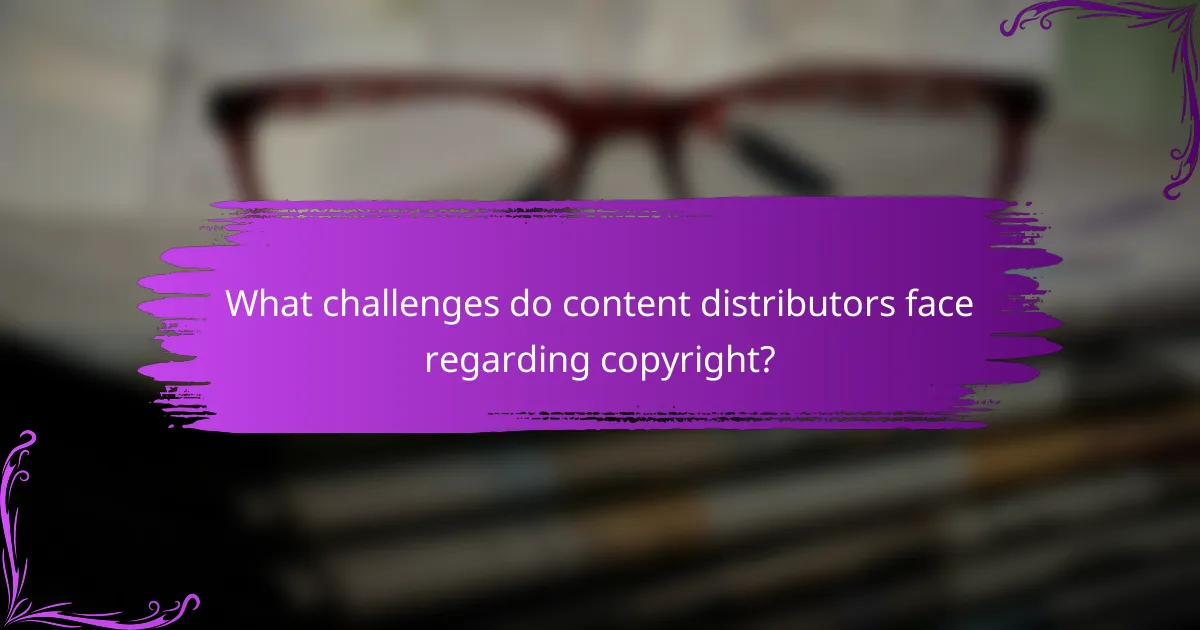
What challenges do content distributors face regarding copyright?
Content distributors face significant challenges regarding copyright compliance and infringement. One major challenge is the complexity of copyright laws, which vary by country. Distributors must navigate these laws to avoid legal repercussions. Another challenge is the risk of unintentional infringement when using third-party content. This can lead to costly legal disputes and potential loss of revenue. Additionally, tracking the ownership of digital content can be difficult due to the vast amount of material available online. Distributors also face the challenge of managing licensing agreements, which can be intricate and time-consuming. Lastly, the rise of user-generated content complicates copyright enforcement, as it blurs the lines of ownership and responsibility.
How does infringement occur in digital content distribution?
Infringement occurs in digital content distribution when copyrighted material is used without permission. This can happen through unauthorized downloads, sharing, or streaming of content. For example, users may illegally share music or movies on peer-to-peer networks. Additionally, content can be uploaded to platforms without the rights holder’s consent. Automated tools sometimes fail to detect these violations. According to the U.S. Copyright Office, billions of dollars are lost annually due to copyright infringement. This highlights the significant impact of unauthorized distribution on creators and industries.
What are common examples of copyright infringement?
Common examples of copyright infringement include unauthorized reproduction of copyrighted works. This occurs when someone copies a book or a song without permission. Another example is distributing copyrighted material without authorization. This can happen when films or music are shared online illegally. Additionally, displaying copyrighted images without permission is also infringement. This includes using images on websites or in advertisements. Finally, creating derivative works without consent is another form of infringement. This involves modifying or building upon someone else’s copyrighted work without permission.
How can distributors identify potential infringement risks?
Distributors can identify potential infringement risks by conducting thorough due diligence on the content they plan to distribute. This includes researching the ownership of the content and verifying licensing agreements. Distributors should also review copyright registrations and consult legal databases for existing claims. Monitoring industry trends and case law helps in understanding common infringement issues. Engaging with copyright experts can provide insights into potential risks. Regular training on copyright laws for staff can enhance awareness. Documenting all content sources and agreements serves as a safeguard. These steps collectively reduce the likelihood of unintentional infringement.
What barriers exist for compliance with copyright laws?
Barriers for compliance with copyright laws include lack of awareness, complexity of laws, and enforcement challenges. Many individuals and organizations do not fully understand copyright regulations. This ignorance leads to unintentional infringements. The complexity of copyright laws can confuse creators and users alike. Different jurisdictions have varying rules, making compliance difficult. Enforcement of copyright laws is often inconsistent. Many copyright holders lack resources to pursue legal action. Additionally, digital content distribution complicates tracking and enforcing rights. These factors collectively hinder compliance with copyright laws.
How do varying copyright laws complicate international distribution?
Varying copyright laws complicate international distribution by creating legal inconsistencies across countries. Each nation has its own copyright regulations, which may differ significantly. These differences can lead to confusion regarding what content can be legally shared or sold. For example, a work protected in one country may not have the same protection in another. This can result in unauthorized use or infringement claims. Additionally, varying enforcement mechanisms can complicate compliance for distributors. Companies must navigate these laws carefully to avoid legal disputes. The lack of a universal copyright framework exacerbates these challenges.
What are the financial implications of copyright compliance?
Copyright compliance has significant financial implications for businesses and individuals. Non-compliance can lead to hefty fines and legal fees, which can reach thousands or even millions of dollars. For instance, the U.S. Copyright Office reports that statutory damages for infringement can range from $750 to $30,000 per work. In cases of willful infringement, damages can escalate to $150,000 per work. Additionally, companies may incur costs related to licensing fees for copyrighted materials. These fees can vary widely based on the type of content and usage rights required. Furthermore, compliance may necessitate investment in legal counsel and copyright management systems. Such expenditures can strain budgets, especially for small businesses. Therefore, understanding and adhering to copyright laws can ultimately save organizations from substantial financial losses.
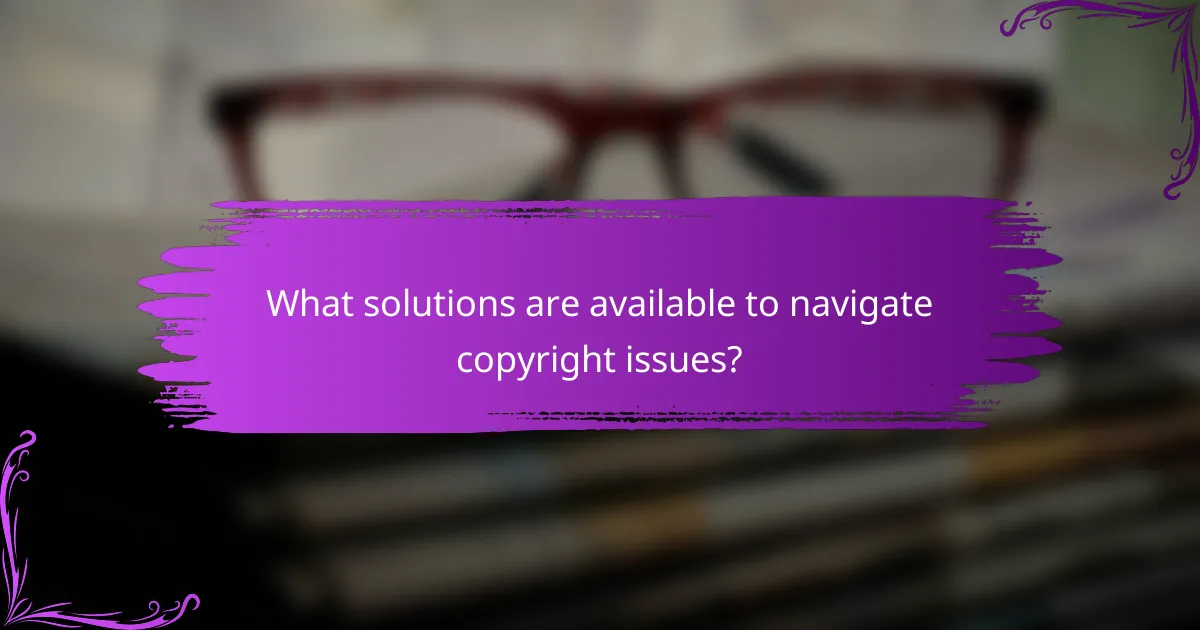
What solutions are available to navigate copyright issues?
Solutions to navigate copyright issues include obtaining licenses, using public domain works, and employing fair use principles. Licensing allows creators to legally use copyrighted material by obtaining permission from the rights holder. Public domain works are not protected by copyright and can be freely used without permission. Fair use permits limited use of copyrighted material for purposes such as criticism, comment, news reporting, teaching, scholarship, or research. Each of these solutions provides a framework for legally managing copyright concerns in content distribution.
How can content creators protect their work effectively?
Content creators can protect their work effectively by registering their copyright. Copyright registration establishes legal ownership and provides evidence in case of infringement. It allows creators to pursue legal action against unauthorized use. Additionally, using watermarks can deter unauthorized reproduction of visual content. Content creators should also utilize licenses that specify how their work can be used. This clarifies permissions and restrictions for others. Furthermore, keeping detailed records of creation dates and drafts strengthens claims of originality. According to the U.S. Copyright Office, registered works are eligible for statutory damages and attorney fees in infringement cases. These measures collectively enhance the protection of creative works.
What are the benefits of registering copyrights?
Registering copyrights provides legal protection for original works. It grants the creator exclusive rights to reproduce, distribute, and display their work. This registration establishes a public record of ownership. It also enables the creator to sue for infringement in federal court. Registered works can receive statutory damages and attorney fees if infringed. Additionally, registration is necessary for certain international protections under treaties. The U.S. Copyright Office reports that registration significantly strengthens enforcement efforts. Thus, registering copyrights safeguards creative investments and promotes fair use.
How can licenses and agreements help in content distribution?
Licenses and agreements facilitate content distribution by legally defining usage rights. They clarify how content can be shared, modified, or sold. This legally binding framework protects the rights of creators. It ensures that content is used in accordance with copyright laws. For instance, a licensing agreement can specify the territories in which content can be distributed. It can also outline the duration of the content’s use. Such agreements help prevent unauthorized use, which can lead to legal disputes. By establishing clear terms, licenses and agreements promote trust between content creators and distributors.
What role do technology and tools play in copyright management?
Technology and tools play a crucial role in copyright management by automating processes and enhancing enforcement. Digital rights management (DRM) software helps protect copyrighted materials by controlling access and usage. Copyright registration tools simplify the process of securing rights, making it more efficient for creators. Additionally, content identification technologies, like fingerprinting and watermarking, help track and manage the use of copyrighted content across platforms. According to the U.S. Copyright Office, these technologies are essential for combating infringement in the digital age. Overall, technology streamlines copyright management and strengthens the protection of intellectual property.
How can digital rights management (DRM) assist content distributors?
Digital rights management (DRM) assists content distributors by protecting their intellectual property. DRM technologies restrict unauthorized access and copying of digital content. This ensures that distributors can maintain control over how their content is used and shared. By implementing DRM, distributors can enforce licensing agreements effectively. This leads to increased revenue through legitimate sales and subscriptions. According to a report by the Business Software Alliance, companies using DRM can reduce piracy by up to 50%. Consequently, DRM helps to secure the financial viability of content distribution.
What are the best practices for using copyright management software?
Utilizing copyright management software effectively requires adherence to several best practices. First, ensure accurate metadata entry for all copyrighted materials. This includes title, author, and copyright date. Second, regularly update the software to access new features and security improvements. Third, train all users on the software’s functionalities and copyright laws. This enhances compliance and reduces errors. Fourth, establish clear workflows for tracking and managing copyright licenses. This helps maintain organization and accountability. Fifth, conduct regular audits of copyright assets to identify and resolve potential issues. Lastly, integrate the software with other content management systems for seamless operation. These practices enhance the efficiency and effectiveness of copyright management efforts.
What can we learn from case studies on copyright in content distribution?
Case studies on copyright in content distribution reveal critical insights into legal practices and industry standards. They illustrate how various entities navigate copyright challenges while distributing content. For instance, the case of the Recording Industry Association of America (RIAA) vs. Napster highlighted the importance of licensing agreements. It underscored the necessity for platforms to secure rights before distributing copyrighted material. Additionally, the case of Google Books demonstrated the complexities of fair use and transformative use in digital distribution. This case emphasized how courts assess the balance between copyright protection and public access. Overall, these case studies provide valuable lessons on compliance, risk management, and the evolving landscape of copyright law.
What notable cases illustrate successful copyright navigation?
The notable case of “Campbell v. Acuff-Rose Music, Inc.” illustrates successful copyright navigation. In this 1994 Supreme Court case, the Court ruled that 2 Live Crew’s parody of Roy Orbison’s song “Oh, Pretty Woman” was fair use. The decision emphasized that transformative use can qualify for fair use protection. Another example is “Authors Guild v. Google, Inc.” This 2015 ruling found that Google’s book scanning project constituted fair use. The court noted that the project provided significant public benefits, such as increased access to information. These cases highlight how courts navigate copyright law to balance protection with public interest.
How have legal precedents shaped current copyright practices?
Legal precedents have significantly shaped current copyright practices by establishing foundational legal principles. Landmark cases like “Copyright Act of 1976” set the framework for copyright duration and ownership. The “Betamax case” (Sony Corp. v. Universal City Studios, 1984) affirmed the legality of time-shifting, influencing fair use standards. The “Google Books case” (Authors Guild v. Google, 2015) addressed digitization and fair use, impacting how digital libraries operate. These precedents clarify rights and limitations for creators and users. They also influence how courts interpret copyright law in new contexts. Overall, legal precedents guide the evolution of copyright practices in response to technological advancements.
What practical tips can content distributors follow to avoid copyright issues?
Content distributors can avoid copyright issues by adhering to several practical tips. First, they should always obtain permission before using copyrighted material. This ensures that the original creator’s rights are respected. Second, distributors should utilize Creative Commons licenses, which allow for legal sharing under specific conditions. Third, they must provide proper attribution to the original creators when using their work, as this acknowledges their contributions. Fourth, distributors should familiarize themselves with fair use guidelines, which outline permissible uses of copyrighted material without permission. Fifth, they can create original content to eliminate reliance on others’ work. Lastly, maintaining a clear record of permissions and licenses can help in case of disputes. Following these practices helps minimize the risk of copyright infringement.
Navigating copyright issues in content distribution involves understanding key challenges such as unauthorized reproduction, licensing agreements, and fair use. The article explores how copyright laws impact content creators, the types of protections available, and the differences in laws across regions. Additionally, it examines the risks of infringement, the financial implications of compliance, and practical solutions for content distributors. Case studies highlight successful navigation of copyright challenges, providing valuable insights into best practices for avoiding legal disputes and ensuring proper use of copyrighted material.
